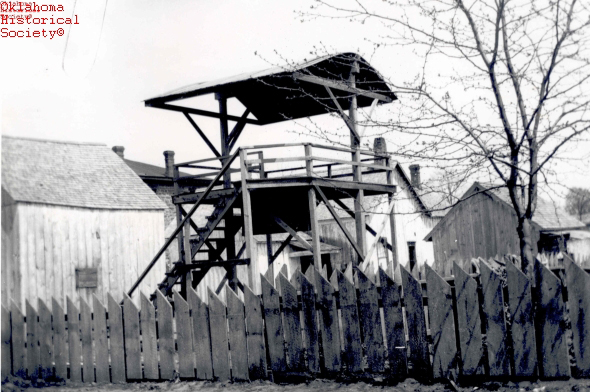The Encyclopedia of Oklahoma History and Culture
CAPITAL PUNISHMENT.
Capital punishment has been the law in Oklahoma since 1804, when Congress made the criminal laws of the United States applicable in the Louisiana Purchase, which included present Oklahoma. These legal codes included the crime of "willful murder," carrying the death penalty. Through the years Congress found other offenses, including rape, that merited capital punishment as well.
Until Oklahoma 1907 statehood, capital crimes committed in Indian Territory were tried in the federal courts for Arkansas, Kansas, and Texas. However, the U.S. District Court for the Western District of Arkansas, presided over by notorious Judge Isaac C. Parker, was Indian Territory's most famous criminal venue, with seventy-nine men going to the gallows under sentence of his court.
In 1889 Congress established a U.S. district court at Muskogee, the first federal court resident in Indian Territory. However, the court did not have jurisdiction of capital offenses, which continued to be tried in the federal courts for Arkansas, Kansas, and Texas. In 1890 a territorial government, with its own judicial structure, was established for Oklahoma Territory. Until statehood, capital crimes committed in Oklahoma Territory were prosecuted in the territorial courts.
In 1895 Congress gave the Muskogee court, as of September 1, 1896, exclusive jurisdiction of all offenses committed against the laws of the United States in Indian Territory and repealed the jurisdiction of the Arkansas, Kansas, and Texas federal courts. One man was hanged under sentence of the Oklahoma Territory courts, and nine men and one woman went to the gallows under sentence of the Indian Territory court. From statehood until 1915 executions were by hanging in the county of conviction. The records are not perfect, but the number of people hanged between statehood and 1915 is probably six, all men accused of murder. The number would have been higher but for Lee Cruce, Oklahoma's second governor.
Cruce was an inveterate foe of the death penalty. The best information is that only one person was executed during his term in office (1911–15), while at least twenty-two murderers escaped the hangman's noose. Cruce's successor, Robert L. Williams, did not share his view on capital punishment, and executions began again when Williams took office. The first year of Williams's term also saw Oklahoma change from hanging to electrocution as a method of execution.
In 1915 Henry Bookman, convicted in McIntosh County for murder, was the first person to be electrocuted in Oklahoma. The first execution for an offense other than homicide occurred in 1930. James Edward Forrest was put to death for rape, and subsequently there were executions for robbery with firearms and for kidnapping. In the late 1920s and during the 1930s there were as many as three on the same day. In 1972, when the U.S. Supreme Court declared the death penalty, as then administered, unconstitutional, eighty-two persons, all male, had died in Oklahoma's electric chair.
After the Supreme Court's ruling, states began attempting to enact constitutional death penalty statutes. Gov. David Boren convened a special session of the legislature in July 1976 to restore the capital punishment in Oklahoma. The legislators overwhelmingly voted in favor, 45 to 1 in the senate, and 93 to 5 in the house. The first execution under the new law occurred in 1990. From 1915 to March 2004, Oklahoma had executed 156 individuals, including three women. Between 1915 and 1966 eighty-two died by electrocution, and one was hanged. Seventy-three died from lethal injection between September 1990 and March 2004.
See Also
LEE CRUCE, GOVERNMENT AND POLITICS, LYNCHING, ISAAC CHARLES PARKER
Learn More
Ruth Fisk Bowman, "Death By Hanging: The Crimes and Execution of Arthur Gooch," The Chronicles of Oklahoma 62 (Summer 1984).
"Capital Punishment, Oklahoma," Vertical File, Jan Eric Cartwright Memorial Library, Capitol Building, Oklahoma City.
"Capital Punishment," Vertical File, Oklahoma Room, Oklahoma Department of Libraries, Oklahoma City.
Louis Coleman, "'We Are Making History': The Execution of William Going," The Chronicles of Oklahoma 76 (Spring 1998).
Von Russell Creel, "Capital Punishment and the United States Court for the Indian Territory," The Chronicles of Oklahoma 81 (Summer 2003).
Von Russell Creel, "On the Gallows' Edge: Capital Punishment, Appeals, and Presidential Clemency in Indian Territory, 1896–1907," The Chronicles of Oklahoma 84 (Summer 2006).
Bob Gregory, "They Died For Their Sins," Oklahoma Monthly (December 1976).
Citation
The following (as per The Chicago Manual of Style, 17th edition) is the preferred citation for articles:
Von Russell Creel, “Capital Punishment,” The Encyclopedia of Oklahoma History and Culture, https://www.okhistory.org/publications/enc/entry?entry=CA052.
Published January 15, 2010
© Oklahoma Historical Society


